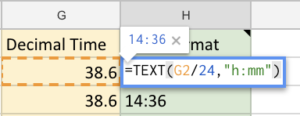
Decimal to Hours Converter
Hours to Decimal Converter
What is Decimal Time?
Decimal time is a method of representing time in a decimal format rather than the traditional 60-minute per hour format. In decimal time, each hour is divided into 100 units, and each unit represents 0.6 minutes (or 36 seconds).
For example:
- 1 hour = 1.00
- 30 minutes = 0.50
- 15 minutes = 0.25
- 10 minutes = 0.17
How to Convert Time to Decimal Format
Converting time to decimal format is a straightforward process. Here’s a step-by-step guide:
- Start with the hours worked as a whole number.
- Convert the minutes worked to a decimal by dividing the minutes by 60.
- Add the decimal from step 2 to the whole number of hours from step 1.
For example, if an employee worked 7 hours and 30 minutes:
- 7 hours
- 30 minutes ÷ 60 = 0.50
- 7 + 0.50 = 7.50 (decimal time)
To make the process even easier, you can use a decimal time conversion chart or our online decimal time calculator, which is listed here.
Decimal time is fairly common because it makes it easy to add and subtract times, thus making it frequently used in both accounting and time-keeping solutions. When filling out time cards, you typically report that you were at work for let’s say, 8 hours and 15 minutes, and the next day you worked for 11 hours and 25 minutes. With this chart, you can simply find the minutes you worked and see what the decimal would be. Converting them to 8.25 and 11.42 makes it easier to add your time at the end of the week.
Within a time tracking software, reports you generate will export in a decimal format. These are in fact the same, just displayed differently. Advanced time tracking apps like busybusy partner with accounting services to easily upload timesheet entries for a quick and accurate payroll process. A free time card calculator has been made to simplify your process.
Converting the time can be confusing, but it doesn’t have to be!

Convert Time from Hour & Minute Format to Decimal using Excel
Convert the decimal time to your desired format in Excel by dividing the time by 24 and then formatting the result. You can also use Excel in-built formulas such as CONVERTor HOUR/MINUTE/SECOND

Why is Decimal Time Used in Payroll?
- Simplifies Calculations: Decimal time simplifies payroll calculations by eliminating the need to convert minutes to fractions of an hour. Instead of dealing with complex fractions, you can work with clean, whole numbers, reducing the risk of errors.
- Streamlines Data Entry: When employees log their hours in decimal format, it makes data entry more efficient. Payroll managers can quickly input the hours without the need for manual conversions, saving time and effort.
- Ensures Accuracy: Decimal time reduces rounding errors that can occur when converting minutes to fractions of an hour. By using a standardized decimal format, you ensure that employees are paid accurately for the exact amount of time worked.
- Facilitates Integration: Many payroll software systems and time tracking tools are designed to work with decimal time. By using this format, you can seamlessly integrate data from various sources without the need for additional conversions.
Tips for Implementing Decimal Time in Your Payroll Process
- Educate Your Team: Make sure your employees understand the concept of decimal time and how to properly log their hours. Provide clear instructions and examples to avoid confusion.
- Use Consistent Formatting: Establish a standard format for logging time, such as using two decimal places (e.g., 7.50 instead of 7.5). Consistency helps prevent errors and makes data entry more efficient.
- Double-Check Calculations: While decimal time simplifies calculations, it’s still important to double-check your math. Use payroll software with built-in validation features to catch any potential errors.
- Keep Detailed Records: Maintain accurate records of employee hours, including any adjustments or corrections. Detailed records are essential for audits and compliance purposes.
Conclusion
Understanding and utilizing decimal time is a crucial skill for payroll managers. By simplifying calculations, streamlining data entry, and ensuring accuracy, decimal time helps make your payroll process more efficient and error-free. With the steps and tips provided in this guide, you’ll be well-equipped to implement decimal time in your organization’s payroll practices.
Remember, embracing decimal time is not just about adapting to industry standards; it’s about optimizing your payroll process to save time, reduce errors, and ensure fair compensation for your employees.
Having a software that converts time automatically for you is a must for every business owner. See how the time tracking app busybusy will help you convert time, and generate accurate reports! You can’t afford not to.











